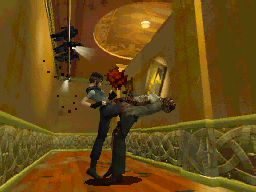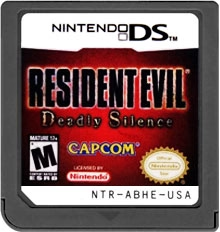
Resident Evil: Deadly Silence is a portable adaptation of the original 1996 Resident Evil, released for the Nintendo DS to commemorate the series’ tenth anniversary. The story follows the S.T.A.R.S. Alpha Team as they investigate the mysterious disappearance of their comrades in the Arklay Mountains, only to become trapped inside the sinister Spencer Mansion. Players once again take control of Chris Redfield or Jill Valentine, navigating the mansion’s halls, solving puzzles, and fighting against grotesque biological monsters created by the Umbrella Corporation. The narrative remains faithful to the original game, capturing the iconic mix of mystery, survival, and horror that defined the series.
Developed and published by Capcom, Deadly Silence was released in Japan in January 2006 and in North America and Europe later that year. It was designed to celebrate the legacy of Resident Evil while taking advantage of the Nintendo DS’s unique hardware features. The project was not a simple port but rather a reimagined version of the classic survival horror experience with adjustments to gameplay and new content that made use of the dual screens, touchscreen, and microphone. As a tenth-anniversary release, it stood as a reminder of how much the franchise had grown since its debut, while also offering a nostalgic return to its roots.









Gameplay
The game features two distinct modes: Classic Mode and Rebirth Mode. Classic Mode preserves the original PlayStation experience with traditional tank controls, pre-rendered backgrounds, and fixed camera angles. Rebirth Mode, however, incorporates DS-specific mechanics such as knife combat using the touchscreen, microphone-based actions like resuscitating allies or blowing away poison gas, and new enemy placements to increase tension. Combat remains deliberately challenging, with limited ammunition and fragile health items pushing players to conserve resources. The dual-screen display also improved inventory management, allowing quick access to items without pausing the action. These changes created an experience that blended nostalgia with fresh mechanics, making it stand out as more than a simple port.
Visuals & Style
Graphically, Deadly Silence stayed close to the PlayStation original, with pre-rendered backgrounds and polygonal character models adapted for the Nintendo DS. While the hardware limitations meant visual compromises, the art style retained the eerie atmosphere of the Spencer Mansion. The dimly lit corridors, shadowy corners, and grotesque enemy designs preserved the unsettling tone that made the original famous. The DS sound hardware recreated the haunting soundtrack and chilling sound effects with reasonable fidelity, ensuring the game’s atmosphere remained intact. Though not as advanced as later remakes like Resident Evil on GameCube, it succeeded in delivering a portable yet authentic survival horror presentation.
Importance in Survival Horror History
Deadly Silence holds an interesting place in survival horror history because it represents one of the few times a mainline Resident Evil was adapted for a handheld console. At a time when the franchise was transitioning toward more action-oriented gameplay in Resident Evil 4, this DS release reminded players of the slower, more methodical survival horror roots. It also experimented with how touch and microphone controls could be integrated into horror mechanics, setting an example of how portable systems might handle the genre. For many fans, it offered the definitive way to experience the original game on the go, preserving the tension and resource management that defined early survival horror.
Reception vs Historical Value
Upon release, Resident Evil: Deadly Silence received generally favorable reviews. Critics appreciated the faithful recreation of the original and praised the addition of Rebirth Mode, which added new life to familiar gameplay. Some reviewers criticized the graphics as dated compared to the GameCube remake and noted that touchscreen mechanics could feel gimmicky. However, fans of the series largely embraced the game, valuing it as both a celebration of the franchise’s history and a portable survival horror experience. Historically, its value lies in bridging the gap between the franchise’s origins and its modern evolution, offering a snapshot of how Capcom balanced tradition with experimentation.
Availability & Collectibility



The game was released exclusively for the Nintendo DS and has not been reissued on any other platform, making physical cartridges the only way to play today. While it is not as rare or expensive as some other survival horror titles from the same period, prices for complete copies have steadily risen due to its status as a unique anniversary release and the enduring popularity of the Resident Evil franchise. For collectors of survival horror or Resident Evil memorabilia, Deadly Silence remains a desirable item, representing both nostalgia and a distinctive handheld experiment in the series’ long history.
Trailer :
